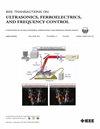Nuclear Irradiation and Characterization of Langasite SAWR Sensors up to 800 ∘C
IF 3
2区 工程技术
Q1 ACOUSTICS
IEEE transactions on ultrasonics, ferroelectrics, and frequency control
Pub Date : 2024-12-19
DOI:10.1109/TUFFC.2024.3520421
引用次数: 0
Abstract
For next-generation advanced nuclear reactors, there is a significant need for new sensor materials and sensor technologies that are capable of withstanding in-core high gamma radiation (e.g., >10 Gy/s), neutron flux levels [800°C以下Langasite sar传感器的核辐照和特性
对于下一代先进的核反应堆,需要能够承受堆芯内高伽马辐射(例如,>10 Gy/s)、中子通量水平[$\ gt10 ^{{12}}$ n/(cm $^{{2}} \cdot $ s)]和高工作温度($\ gt700 ~^{\circ}$ C)的新型传感器材料和传感器技术。并在一个研究级试验堆中进行了测试,并展示了通过监测根据反应堆总中子通量校准的SAWR频率响应来量化总中子通量的能力,当暴露于反应堆功率为100、300和461 kW[或0.42、1.3和2.0\乘以10^{{2}}$ n/(cm $^{{2}} \cdot $ s)]时,温度高达800~^{\circ}$ C,最大伽马剂量率为21 Gy/s。伽马加热对SAWR传感器频率响应的影响是通过使用现场炉的仪表控制来解释的,在现场炉中,传感器设备在辐照期间加载。受控炉允许在暴露于不同反应堆功率/中子通量水平时,将SAWR装置保持在固定温度。利用这种方法,测量到的传感器频率响应的变化主要归因于中子通量引起的SAWR器件的材料软化。对于在$800~^{\circ}$ C处获得的辐照测量,LGS SAWR传感器产生了频率响应的线性位移,作为反应堆功率的函数,速率约为3 kHz/100 kW。
本文章由计算机程序翻译,如有差异,请以英文原文为准。
求助全文
约1分钟内获得全文
求助全文
来源期刊
CiteScore
7.70
自引率
16.70%
发文量
583
审稿时长
4.5 months
期刊介绍:
IEEE Transactions on Ultrasonics, Ferroelectrics and Frequency Control includes the theory, technology, materials, and applications relating to: (1) the generation, transmission, and detection of ultrasonic waves and related phenomena; (2) medical ultrasound, including hyperthermia, bioeffects, tissue characterization and imaging; (3) ferroelectric, piezoelectric, and piezomagnetic materials, including crystals, polycrystalline solids, films, polymers, and composites; (4) frequency control, timing and time distribution, including crystal oscillators and other means of classical frequency control, and atomic, molecular and laser frequency control standards. Areas of interest range from fundamental studies to the design and/or applications of devices and systems.

 求助内容:
求助内容: 应助结果提醒方式:
应助结果提醒方式:


